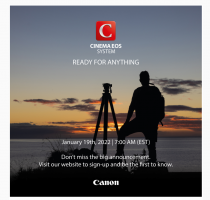I really feel conflicted about this camera.. at first I really want to buy it but now it really needs to fall into the rice price range.. as far as rumors go it's basically a slight improvement over the R5 (a welcomed one though) but I wouldn't put too much money to basically remove a software limit (30min) and software capabilities (logs) that could (but won't) be pushed through firmware updates and a fan..
considering they're tagging their camera with a C though makes me think that canon will go crazy on the price as it's a "C" line afterall..
we shall see soon enough I guess but I'm not paying 5 or 6k for a slightly improved R5
considering they're tagging their camera with a C though makes me think that canon will go crazy on the price as it's a "C" line afterall..
we shall see soon enough I guess but I'm not paying 5 or 6k for a slightly improved R5
Upvote
0

